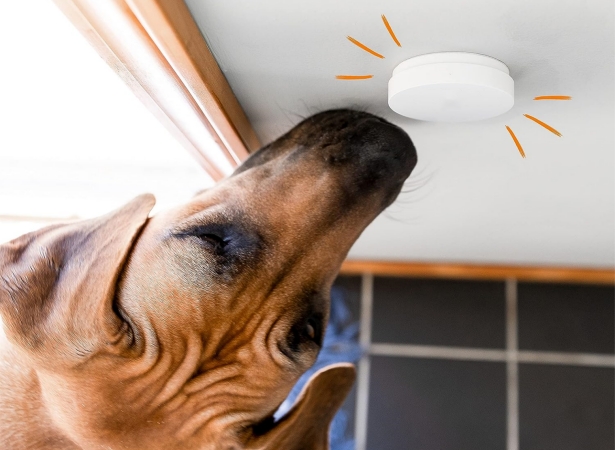
Best Doggie Doorbell:15+ Models Tested for Potty Training
Are you training your doggie doorbell manners, or does your furry friend incessantly scratch or bark at the door to go outside? You need a

If your dog doorbell isn’t ringing as it should, you’re not alone. Many pet owners face the frustration of an unresponsive doorbell, especially when their furry friends depend on it for communication.
In this extensive guide, we’ll delve deep into the steps to identify, fix, and maintain an unresponsive dog doorbell, ensuring it remains a reliable means for your pet to signal their desires.
To effectively troubleshoot and maintain your dog doorbell, it’s essential to comprehend how it works.

A typical dog doorbell consists of a button mechanism that, when pressed by your pet, activates a sound or alert. The complexity of this mechanism varies between mechanical and electronic models. Mechanical doorbells employ simple push-button mechanisms, often connected to a bell or chime.
In contrast, electronic doorbells incorporate more intricate components, including circuit boards, wireless transmitters, and receivers. Understanding these fundamentals is crucial for pinpointing potential issues, whether it’s a stuck button or a malfunctioning circuit.
Dog doorbells come in various styles, each with unique features catering to different needs. Some are basic, straightforward designs, while others offer advanced capabilities such as adjustable volumes, various tones, or even smartphone connectivity for smart doorbells. Familiarizing yourself with your specific doorbell type is essential for effective maintenance and troubleshooting.
Consistent maintenance practices can significantly enhance the longevity and responsiveness of your dog doorbell.
Regular cleaning is vital for a dog doorbell to remain responsive. Dust, dirt, and pet hair can accumulate around the button or inside the mechanism, impeding its function.
It’s advisable to gently clean the button area and any accessible parts using a soft cloth. For mechanical doorbells, a light application of suitable lubricant can help ensure smooth button operation.
For electronic dog doorbells, the battery is the lifeblood of the device. Regularly inspect the batteries, ideally every few months, to ensure they’re in good condition.
If you notice a decrease in the doorbell’s responsiveness, the first step is to replace the batteries with the recommended type.
Always ensure proper battery installation, aligning the positive and negative ends as indicated in the device. Keeping spare batteries on hand can prevent interruptions in your doorbell’s operation.
Don’t let an unresponsive dog doorbell become a hurdle to your pet’s outdoor adventures. Here’s how to tackle common problems.
The initial step in troubleshooting an unresponsive dog doorbell is identifying the root cause. Is the issue related to the button not triggering the chime, or is it a problem with the chime or signal not reaching you?
In mechanical doorbells, it might be as straightforward as a stuck button or a broken chime mechanism. In electronic models, problems can range from depleted batteries to wireless signal disruptions or even software glitches in smart doorbells.
Many electronic dog doorbells offer adjustable sensitivity settings to accommodate different-sized and -strength dogs dogs. If your doorbell isn’t responding to your pet’s touch, it might be set too low. Consult the user manual to make the necessary sensitivity adjustments.

However, exercise caution not to set it too high, as this could result in false alarms caused by accidental brushes or external factors.
Recognizing when a problem with your dog d doorbell is beyond DIY fixes is crucial.
Sophisticated dog doorbells can experience complex electrical problems that require professional attention.
If you’ve attempted basic troubleshooting steps without success, and the issue seems to involve internal circuitry, wiring, or software in smart doorbells, it’s time to consult a professional.
Attempting complex electrical repairs without expertise can lead to further damage or void your device’s warranty.
Before embarking on extensive repairs, check your dog doorbell’s warranty status. Many manufacturers offer warranties that cover specific repairs or replacements.
Taking advantage of these services can be a cost-effective and efficient solution to your doorbell issues.
Additionally, professional services often come with the added benefit of expert advice on preventing future problems.
Being proactive can ensure your dog doorbell remains reliable and durable over time.
To prevent future issues, make it a habit to conduct regular inspections and tests on your dog doorbell. Examine the device for visible signs of wear and tear, including frayed wires, cracks, or loose components.
Periodically test the doorbell to confirm that it’s functioning correctly and reliably. This proactive approach can help you catch potential problems before they escalate into major issues.
The strategic placement of your dog doorbell can significantly impact its longevity. Choose a location that is easily accessible to your pet but protected from extreme weather conditions and high foot traffic.
Additionally, educate all family members, especially children, on the proper use of the doorbell to prevent misuse or accidental damage. Correct usage and placement are key to extending your doorbell’s lifespan.

In conclusion, dealing with an unresponsive dog doorbell doesn’t have to be a daunting task.
By understanding the device’s mechanics, conducting regular maintenance, effectively troubleshooting issues, and knowing when to seek professional assistance, you can keep your dog doorbell in optimal working condition.
Routine checks, proper usage, and timely responses to problems ensure that your furry friend’s signals are never missed.
With these guidelines in mind, you can maintain a happy, hassle-free communication channel between your pet and the outdoors. Remember, a well-maintained dog doorbell means a happier and more contented pet.
Q1: Is it normal for my dog doorbell to become less responsive over time?
A1: Yes, it’s not uncommon for a dog doorbell to become less responsive due to factors like dirt accumulation, battery wear, or electronic glitches. Regular maintenance can help restore its responsiveness.
Q2: Can I use any type of lubricant to improve my mechanical dog doorbell’s button operation?
A2: While lubricating the button mechanism of a mechanical dog doorbell can be helpful, it’s crucial to use a silicone-based or doorbell-specific lubricant. Avoid using common household oils, as they can attract dust and dirt, making the issue worse.
Q3: What should I do if my electronic dog doorbell keeps going off randomly?
A3: If your electronic dog doorbell triggers false alarms, it might be due to overly high sensitivity settings. Consult your user manual to adjust the sensitivity to an appropriate level, preventing accidental triggers.
Q4: How often should I check the batteries in my electronic dog doorbell?
A4: It’s advisable to check the batteries in your electronic dog doorbell every few months, even if it appears to be working fine. This proactive approach helps prevent unexpected power failures.
Q5: Can I repair complex electrical issues in my dog doorbell myself?
A5: Complex electrical issues in advanced dog doorbells, especially smart models, are best left to professionals. Attempting DIY repairs can lead to further damage or void the warranty. Consult a qualified technician for such problems.


Are you training your doggie doorbell manners, or does your furry friend incessantly scratch or bark at the door to go outside? You need a

When it comes to dog pee, much like humans, the urine of animals is a vital health indicator. Just as human urine reveals a lot

Noticed your dog yawn more often than usual? While it’s adorable, it could also be a sign of something to consider if it appears excessive.

Wondering what’s so fantastic about bell train a dog? Picture a world where your furry friend always alerts you when they need to go outside,

Are you training your doggie doorbell manners, or does your furry friend incessantly scratch or bark at the door to go outside? You need a

When it comes to dog pee, much like humans, the urine of animals is a vital health indicator. Just as human urine reveals a lot

Noticed your dog yawn more often than usual? While it’s adorable, it could also be a sign of something to consider if it appears excessive.

Wondering what’s so fantastic about bell train a dog? Picture a world where your furry friend always alerts you when they need to go outside,
Copyright © 2024 doggydogdoorbell. All Rights Reserved.